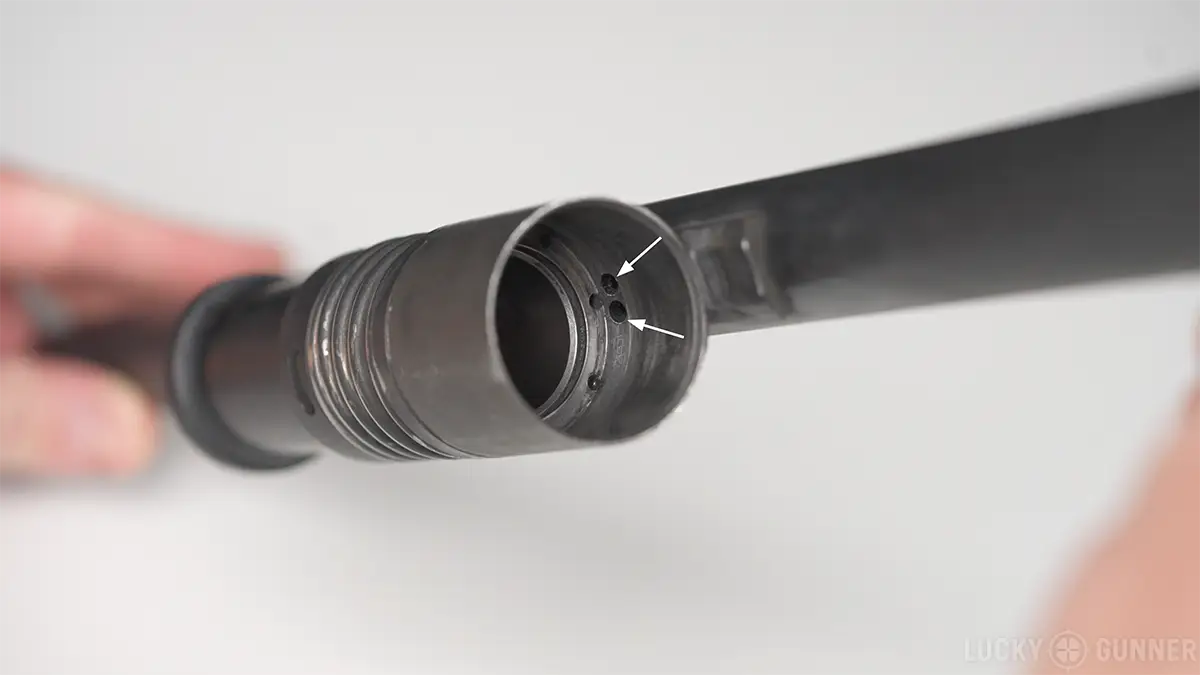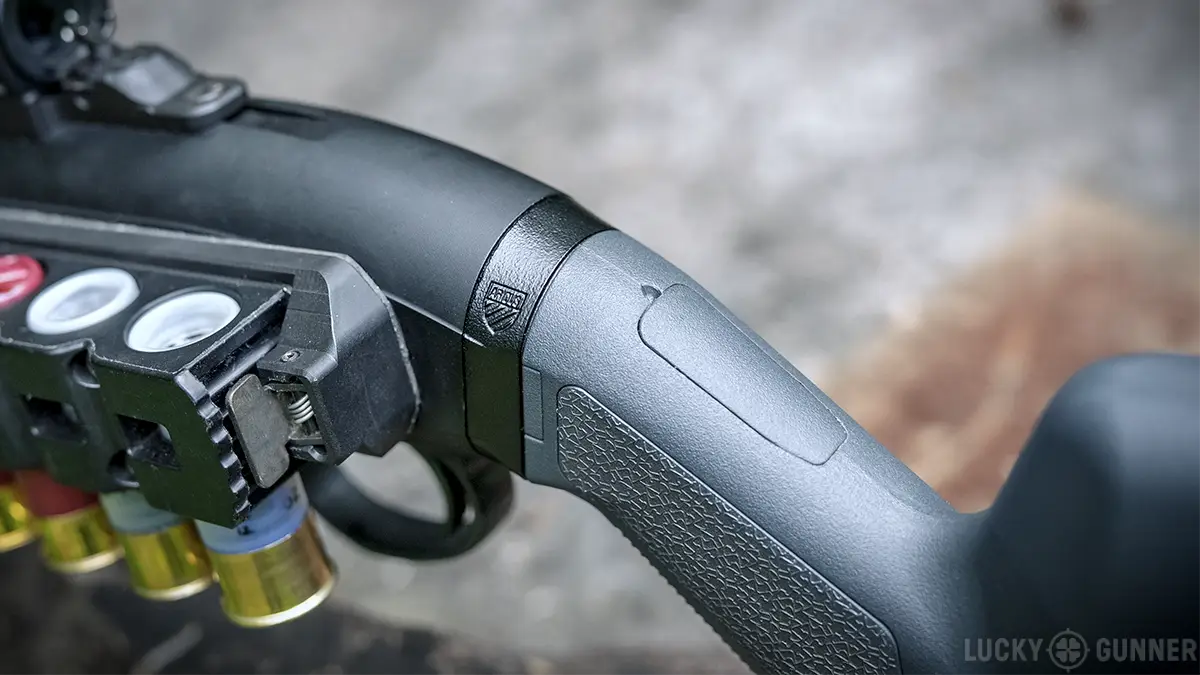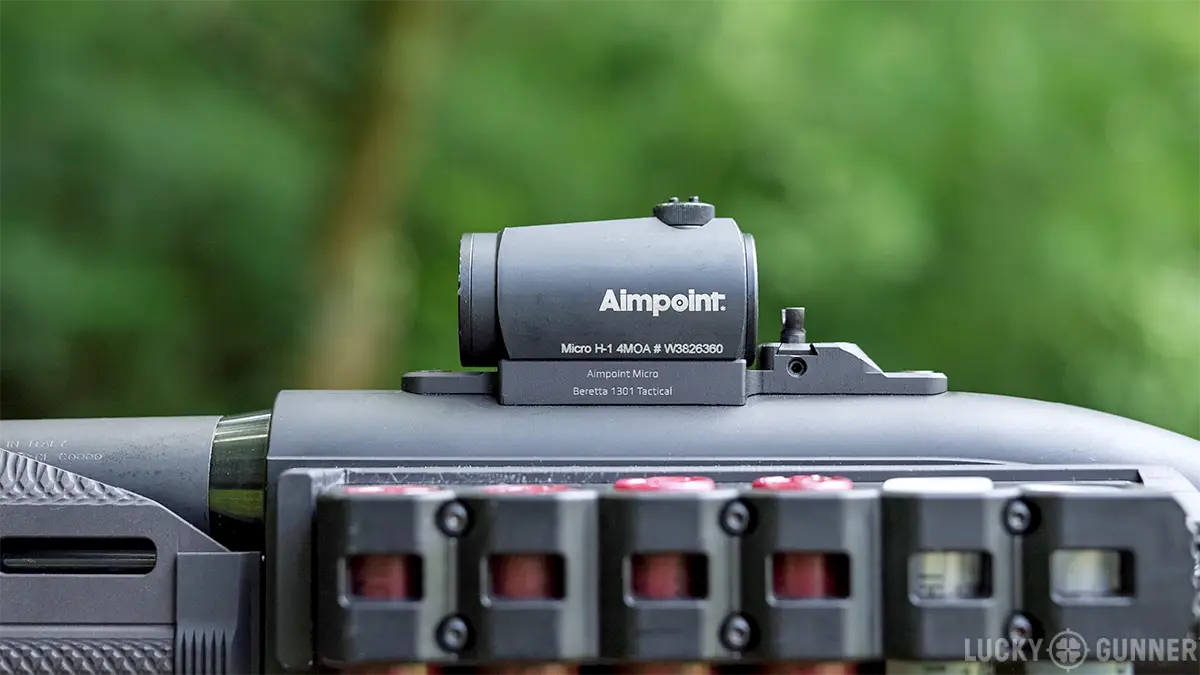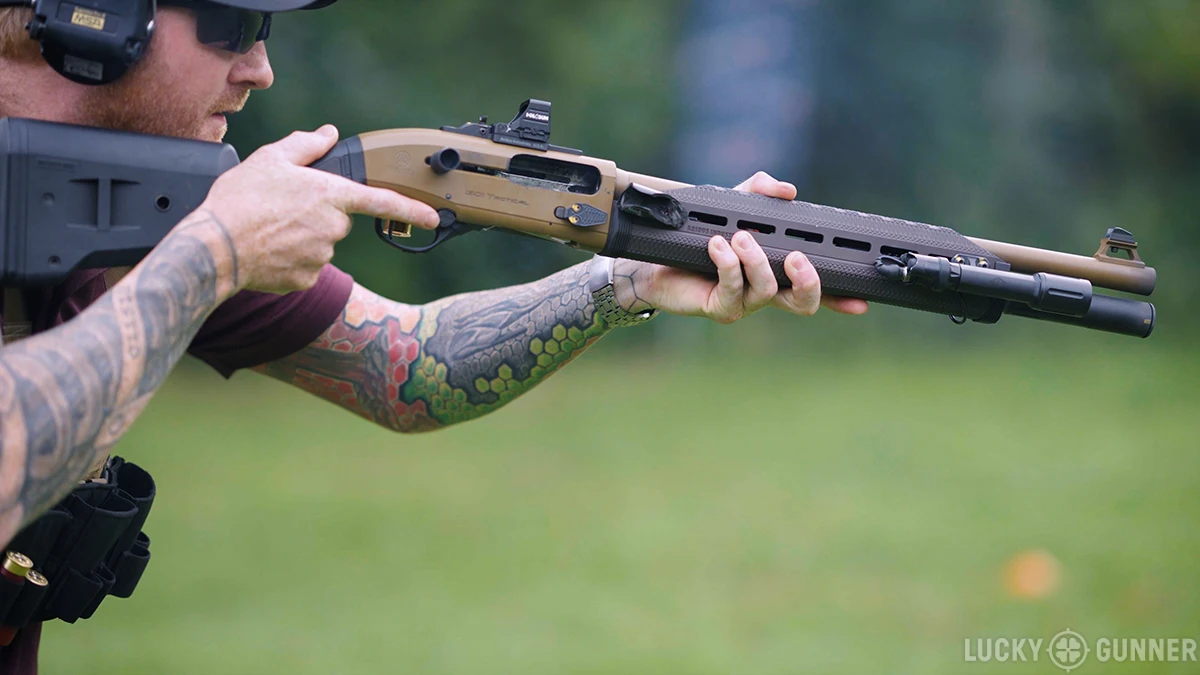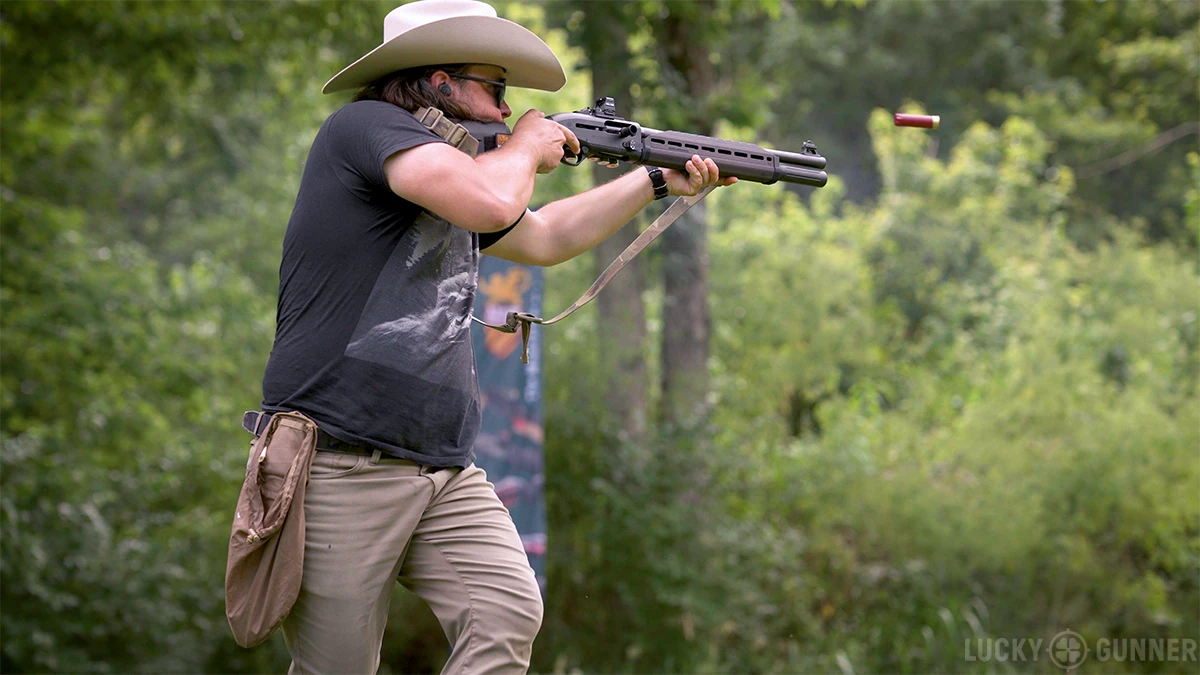I’ve been using the Beretta 1301 Tactical for over a decade, including thousands of rounds and over 120 hours of shotgun classes. In this video, I break down what makes the 1301 stand out, how it’s evolved, and whether it still earns its premium price tag. We’ll also cover reliability, accessories, and what to expect if you’re considering one. Stay tuned for part two, where I’ll share hands-on tips and common handling mistakes.
Details are in the video below, or keep scrolling to read the full transcript.
wistia-player[media-id=’iutxxoq8lu’]:not(:defined) { background: center / contain no-repeat url(‘https://fast.wistia.com/embed/medias/iutxxoq8lu/swatch’); display: block; filter: blur(5px); padding-top:56.25%; }
Hey everybody, I’m Chris Baker from Lucky Gunner and today we’re going to talk about the Beretta 1301 Tactical 12 gauge semi-automatic shotgun.
I’ve owned this shotgun for 10 years now. I’ve reviewed it before, but it’s been a while (and YouTube removed all the old ones anyway). Since the first review, I’ve used it in seven different shotgun classes for a total of 128 hours of training. I’ve spent countless additional hours with it on the range. Thousands of shells fired. It’s appeared in at least half a dozen different shotgun related videos.
And I’ve witnessed an interesting evolution. In the first couple of classes I took this gun to, it was the only semi-auto in the class. Everyone else had pump guns. The last class I attended – a new advanced shotgun class from Rob and Matt Haught of Symtac Consulting last month – all but one student had a 1301. Now, that’s not typical by any stretch, but I think it’s safe to say that the 1301 has become a dominant presence among dedicated students of the shotgun.
This is going to be a two-part review. Today I’ll cover what sets the 1301 apart, whether it’s worth the current price, accessories, and reliability. Next time I’ll get more hands-on with operating tips and common handling mistakes.
What Sets the Beretta 1301 Apart
Semi-automatic fighting shotguns have been around for over a century, from the early Browning Automatic Messenger Gun to more recent options like the Remington 1100 and Benelli M4. But in spite of all these choices, the humble pump action has remained the go-to for combat and personal protection.
It ultimately comes down to reliability. Most semi-auto shotguns are just not very reliable by modern standards, or they’re only reliable with specific types of ammo. They don’t like to cycle with low recoil shells or cheap birdshot most of the time, which is the type of ammo we typically use for training.
That is the challenge Beretta set as their top priority when they developed the shotgun that eventually became the 1301 Tactical. It had to function with a wide range of ammo. Like a lot of semi-auto shotguns, it’s gas operated. With the forend off, you can kind of see what’s going on here.
There are a couple of ports drilled between the barrel and this cylinder here.
When a shot is fired, some of the gas goes through those ports and it pushes out this piston. The piston pushes the bolt carrier which cycles the bolt. What makes this reliable is that the gas ports are oversized, so they let through more gas than they really need to cycle the gun. There are a bunch of vent holes in the front of the cylinder that vent out all the excess gas. High velocity/ high pressure loads vent more gas than low pressure loads.
So the result is a shotgun that runs exceptionally well with just about any kind of ammo. The gas system also absorbs a lot of felt recoil, so it’s a very soft-shooting gun, despite having an aluminum receiver. It’s only 6.7 pounds in the factory configuration.
In my experience, the gun just works. I run a lot of low recoil shells – birdshot, buckshot, and slugs advertised at around 1200 feet per second. Really mild stuff. The 1301 has no problem cycling any of it. And it’s fine with heavier loads, too. Cheap ammo. Dirty ammo. There’s nothing to adjust or tweak. Just grab whatever ammo you have and go.
Aside from reliability, Beretta also gave the 1301 a much nicer barrel than you get on other tactical shotguns. It’s chrome-lined and back-bored. That means the inside of the barrel has an extra long gradual taper – the forcing cone – that helps funnel and direct the shot so you get tighter and more consistent patterns. Accuracy with slugs is also very impressive. Mine will shoot groups no wider than my hand at 50 yards.
The Pricing Reality Check
Okay, but how much does it cost? The current model – the 1301 Tactical C – sells for around $1700. A bit more if you want a color other than black or a pistol grip stock. That’s caused some grumbling because 1301 prices have jumped around quite a bit over time.
The 1301 was originally marketed as the Beretta TX4. It came out in 2010 with a price tag of $1500. And… nobody bought them. So Beretta made some tweaks based on customer feedback and they found a few ways to cut costs so they could lower the price.
It was relaunched in 2014 as the Beretta 1301 Tactical and they sold for around $800-900. That was a phenomenal value, and I have no doubt that the lower price helped attract shotgun fans who had overlooked the TX4.
But as the popularity of the 1301 has grown in the last decade, so has the MSRP. No surprise there. When a thing is more popular, you can charge more for it. Plus, everything costs more now with inflation.
But Beretta has also made some additional improvements over time. Since I got this one, they’ve improved the function of the bolt release latch and the shell lifter. New 1301s now come threaded for chokes. You can get them with a 7-round mag tube from the factory (they used to only come with 5-shot tubes and you had to buy an aftermarket extension like this one). The factory forend now comes with M-Lok attachment points for a weapon mounted light or other accessories.
Does all of that make it worth the cost? I can’t answer that for you — I can tell you it’s a very good shotgun. I do think you get more tangible benefits from a 1301 than you do with something like a higher-end AR-15 versus a mid-level AR. You don’t have to be a shotgun snob to notice the advantages you get from a 1301 over a $700 pump action.
Having said that, some other semi-auto shotguns have entered the scene in the last few years. And one of them also happens to be from Beretta: the A300 Ultima Patrol. I haven’t had any serious range time with one yet, but I’ve got a review planned for the not too distant future.
It’s made in Beretta’s US factory here in Tennessee and costs just over $1000. It’s missing some of the features the 1301 has. The barrel is a bit more basic compared to the 1301’s. It’s an older Beretta barrel design, but it is threaded for chokes. The gas system is the same, so it should be as reliable as the 1301 with most ammo. I don’t want to give it a full recommendation until I’ve had more time with one, but I’m hearing a lot of good stuff about the A300 so far.
If you just want a good semi-auto shotgun that works, it’s probably worth considering. If you’re a serious shotgun nerd and you have the budget for it, the 1301 will give you the best possible performance.
Beretta 1301 Accessories
Let’s look at accessories. You might have noticed I’ve got a bunch of aftermarket parts on this 1301. But I want to point out that the stock, out-of-the-box 1301 is excellent. You don’t really have to have any of these modifications or parts. There are a couple I would strongly recommend, but the rest fall more in the “nice to have” category.
Most of the parts I have on here are from Aridus Industries, which has become a huge supporter of this platform. Full disclosure: I’m friends with Adam from Aridus and he’s hooked me up with some of these parts to try out, but I’m under no obligation to say nice things about them.
The two mods here I’ve gotten the most out of by far are the stock adapter and the optic mount. The factory stock gives you a 13-inch length of pull. Better than most factory stocks for sure. Most people, even some tall people, will benefit from a slightly shorter stock. The Aridus adapter lets you mount a Magpul Mossberg SGA stock. Take out all the spacers and your LOP is down to about 12 ¼”. You can also add a cheek riser to the Magpul stock and the grip is a little better suited for recoil management with the push-pull technique.
I would not recommend any of the pistol grip stocks. In all the shotgun classes I’ve attended, I can count on one hand the number of people I’ve seen shoot really well with pistol grip stocks. There are some use cases where they make sense, but generally they’re not ideal. Pistol grips direct the recoil force into your thumb and wrist instead of absorbing it with your whole upper body. I know a lot of people want their shotgun set up just like their AR, but… shotguns are not ARs.
The optic mount is the Aridus CROM. It’s a combination mount and rear sight. You can direct- mount any optic with an Aimpoint Micro footprint, or you can get the other version with the RMR footprint. This sets the optic much lower than the factory picatinny rail so you can get a better cheek weld. It holds zero better. It allows co-witness with the iron sights, which is not possible with the factory rail. This one has the optional Haught Mod rear sight, which is a ghost ring with the top half chopped off. That reduces clutter in the sight picture, but still gives you a good enough aiming reference for typical shotgun distance. I zeroed this optic with my favorite slugs about seven years ago and have not had to make a single adjustment since.
Other accessories: the Aridus QD shell carrier. Extremely rugged and well designed. It will not let go of your shells until you want it to. But probably overkill for most people. Unless you store the gun in the back of a vehicle or somewhere the shells will vibrate loose, an elastic shell carrier from Vang Comp gets the job done and costs less.
Charging handle. The factory handle works okay, this one is textured aluminum and is kind of nice when your hands are sweaty.
Up here I’ve got a +2 mag tube extension from Nordic Components. Should be unnecessary now since most of the factory guns ship with 7-shot tubes.
Bolt release latch: this Aridus latch corrects a minor problem with the earliest 1301s that does not apply to the later models. The latch on the newer guns has a different issue where the plastic sleeve can sometimes slide out of place and interfere with the latch itself. Aridus also has an aluminum replacement sleeve that will correct that issue if you run into it.
The handguard: this is a brand new option from Aridus as of this month: the Imperium Handguard. This is all aluminum with a really nice texture on it. Great for push-pull. It wraps over the top of the barrel so you don’t have to worry about burning your thumb when the barrel gets hot. It opens up some new options for how you grip the forend.
And the M-Lok slots… M-Lok stuff does not always stay put when it’s mounted to polymer. The aluminum handguard fixes that issue – you get rock-solid mounting. Again, none of that is absolutely necessary – it’s a bunch of small but noticeable benefits that you’ll appreciate if you put a lot of rounds through these things.
Maintenance and Reliability
I’ve mentioned reliability a few times, but let’s talk details. I don’t know how many rounds I’ve got through this gun. No less than 5000, but I think it’s probably a whole lot more than that. I can think of maybe five or six times that it has failed to cycle completely. In every case, the bolt was just slightly out of battery and I had to tap the charging handle to close it.
That’s when I know it’s time to clean and lube the gun. And honestly, I usually just lube it. I’ll break it down and wipe everything off on occasion, but I’ve probably only cleaned out the gas system maybe four times. Now, I don’t recommend that. If you wait that long to clean it, the carbon buildup is really hard to get out of the gas cylinder. It’s been so dirty that all the vent holes were completely plugged up with carbon. But it was still running.
Of course that’s just a sample size of one. I can’t say that every Beretta 1301 will be that resistant to neglect. I’ve seen lots of others run in classes over the years, and they almost always do really well.
The exception was the last class I was in, where two students were having failures to fire. I’m told this is not an uncommon issue if the gun gets too dirty. It’s usually because of fouling in the firing pin channel preventing the firing pin from getting a solid strike on the primer. Or it’s from fouling in the gas ports causing the bolt to not completely cycle. Both of those guns functioned fine after a good cleaning.
Again, I don’t clean my gas system that much, but I’ve never had junk build up in the actual gas ports. And my firing pin channel has never accumulated much fouling either. So your mileage may vary. In any case, don’t follow my example. Clean and lube your 1301. I’d say every 500 rounds seems about right.
To put this in perspective, I have seen a lot more problems with pump actions in classes, both mechanical failures and operator error. I love a good pump action shotgun. I can run an 870 very smoothly. But if I get tired or I’m out of practice, I will start to induce malfunctions every now and again. It’s not super common, but it’s way more common than stoppages with my Beretta 1301.
The Hype is Real
The Beretta 1301 Tactical is reliable, soft-shooting, well-made, and has proven itself in training environments and competition. The price increase over the past decade has definitely changed the value equation, but if you’re serious about shotgun performance and plan to shoot it regularly, it’s the best shotgun of its kind on the market. This is the first gun I would reach for in an emergency. When Chat GPT becomes self-aware and begins its campaign of human annihilation, the 1301 is the gun I will take with me out into the wasteland. That is the highest endorsement I can offer.
Whatever shotgun you end up with, just be sure to shoot it a lot, and get your birdshot, buckshot, and slugs from us with lightning fast shipping at Lucky Gunner.
The post Beretta 1301 Tactical: Still the Best After 10 Years? appeared first on Lucky Gunner Lounge.

